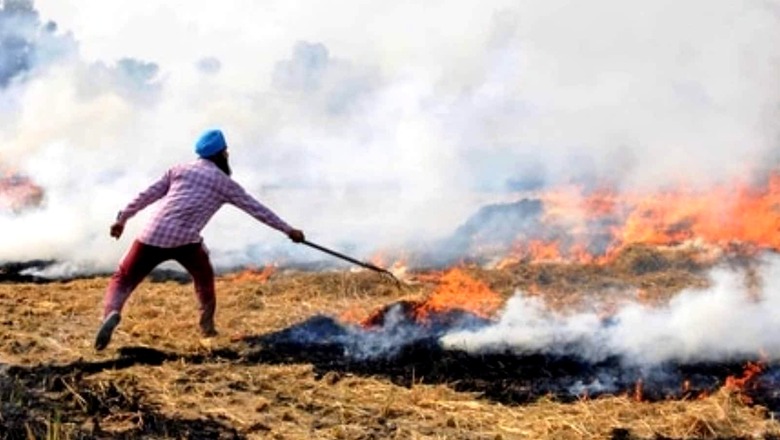
views
With harvesting season round the corner, farmers from Punjab and Haryana have started their annual practice of stubble burning. The issue accounts for a major share in Delhi’s winter air pollution levels and is discussed year after year with no logical, long-term solutions implemented at the end.
Each passing year, authorities find themselves at square zero and, in the end, resign to the deadly smog. Millions of people who continue to dwell in the city have no choice but to breathe the deadly air. However, a monetary incentive-based approach to prevent farmers from stubble burning, if implemented properly, can solve the crisis largely.
Health effects not limited to Delhi
Although news counts health effects only for people in Delhi, stubble burning causes several health issues in Punjab and Haryana as well. Air pollution can contribute to the disease burden of disorders like asthma, stroke, heart disease, lung cancer, etc. Long-term exposure to the hazardous air can cause health issues for people of all ages, including high blood pressure, impaired lung development in infants, cognitive impairments amongst kids, lowered immunity, and depression.
Statistics
Last year, stubble burning in neighbouring states contributed as much as 48 per cent of Delhi’s winter air pollution levels. In terms of the total number of fires reported in Punjab, Haryana, and Uttar Pradesh over the past five years, 2021 was the worst year by far, with a total of 90,984 fires combined in the three states.
Proposal to Pay
Eliminating stubble burning would keep air pollution from reaching highly dangerous levels of 350+ Air Quality Index. A research report by Greenpeace, an independent global campaigning network, says that air pollution in Delhi caused 57,000 premature deaths and an economic loss of Rs 65,000 crore in 2020. The best possible policy solution to this problem is to incentivise farmers for Rs 5,000 per acre to not burn paddy stubble.
Currently, this amount is what it takes to remove stubble from the field without burning in the short sowing period. Both Haryana and Punjab have somewhere around 75,000 acres under paddy cultivation. A rough estimate is this intervention will cost Rs 3,700 crore per state per year. This cost should be distributed equally between the respective state and Delhi.
Why Should Delhi Pay
There are reasons why Delhi should pay farmers from Punjab and Haryana even when the capital city is bearing the brunt of stubble burning. The reason is simple: In India, agriculture is a highly distorted market. The market is distorted by Minimum Support Price, fertiliser subsidy, electricity subsidy, regulations and incentives around when and what to grow. Many ruling parties have tried to use punitive powers to stop this act but have largely failed.
A major reason is due to the inability of small and marginal farmers which account for 85 per cent of the total farmers in the country to pay for stubble disposal. Although the amount is quite significant, it is only 1.18 per cent of Punjab’s 2022-23 expenditure budget, 1.20 per cent of Haryana’s, and 4.88 per cent of Delhi’s. It forms a larger chunk of Delhi’s expenditure because they have to pay for both the states. Although recently, the Union government denied Delhi-Punjab’s request for a share in a similar proposal they brought forth, a case should be made for the Union government to pay a share. This is due to the saving in fertiliser subsidy.
Stubble burning leads to a decrease in soil quality, loss of nutrition and the elimination of friendly microorganisms in the soil. The non-usage of burning stubble leads to a less usage of fertiliser in the subsequent season. Estimates say that the Union government can save around Rs 3,000 per acre in fertiliser subsidy if there is no paddy stubble burning. The incentive should only be given after an assessment has been made that no stubble was burnt on the field with both manual checks and satellite data. The plan should be to phase out the policy gradually after a period of 10 years as the cost of disposal of stubble decreases.
There are additional options for managing stubble. One such is the use of a mechanical stubble remover. Many farmers still cannot afford the machinery, even after receiving a 50-80 per cent subsidy. Fuel and labour used to operate the equipment are additional costs. It is much wiser to provide the farmers a financial incentive so they may choose for themselves which is the best way for them to remove the stubble rather than a subsidy of Rs 75,000-120,000 per machine.
A bio decomposer created by the Indian Agriculture Research Institute (ICAR), which transforms the stubble into mulch, is being given away free to farmers in Delhi. The biggest criticism of the bio decomposer method is that it takes more time than the two to three weeks that farmers usually have to dispose of their stubble.
There are ways through which we can improve and work on finding better alternatives. Finding such alternatives now can help in providing Indians with cleaner air and better diets.
Read all the Latest Opinions here


















Comments
0 comment